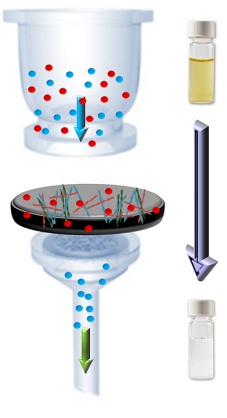Jan 28 2016
A new water filtration system has been developed by ETH researchers. In comparison to existing systems ,it is highly efficient in isolating toxic radioactive substances and heavy metal ions present in water. Gold recovery is another potential application of the new filter.
 The contaminated water (coloured water in vials) is drawn through the hybrid membrane by negative pressure; the heavy metal ions (red spheres) bind to the protein fibres in the process. The filtered water is of drinking quality. (Graphics: Bolisetty & Mezzenga, Nature Nanotechnology, 2016)
The contaminated water (coloured water in vials) is drawn through the hybrid membrane by negative pressure; the heavy metal ions (red spheres) bind to the protein fibres in the process. The filtered water is of drinking quality. (Graphics: Bolisetty & Mezzenga, Nature Nanotechnology, 2016)
During November, Brazil experienced an unprecedented environmental damage. Two dams broke at an iron ore mine, and poisonous heavy metals poured into the Rio Doce reaching the Atlantic Ocean after a few days. The environmental effects were quite severe for humans and nature alike: many fish, animals, and birds died, and 250,000 people went without drinking water.
This disaster illustrates that water pollution is a serious global problem. No effective technical solution exists for treating water mixed with radioactive substances or heavy metals. Current treatment methods for removal of heavy metals are either; too focused on a specific element, or have small filter capacity, additionally they are often very expensive.
A solution to this problem may have been discovered, a new hybrid filter film has been developed in Raffaele Mezzenga’s laboratory. Mezzenga is a professor of Food and Soft Materials at ETH Zurich. The filter membrane has a simple structure, and is made of inexpensive raw materials; such as activated charcoal and whey protein fibers. Heavy metal ions are almost fully removed from water in a single pass through the filter film.
The project is one of the most important things I might have ever done.
Raffaele Mezzenga, Professor of Food and Soft Materials, ETH Zurich
Mezzenga and his researcher, Sreenath Bolisetty, worked on the project, and their work has been published in a recent issue of Nature Nanotechnology.
The filtration system mainly consists of a hybrid membrane, made up of rigid whey protein fibers and activated charcoal, both of which are inexpensive to obtain and easy to produce.
The proteins are denatured, which causes them to stretch and come together as amyloid fibrils. The fibers are applied to a cellulose filter paper acting as a substrate material with activated carbon (present in medical charcoal tablets). The content of carbon is 98%, and protein is 2%.
The hybrid film absorbs heavy metals, including industrially relevant elements, such as mercury, lead, palladium and gold. The membrane also absorbs radioactive substances including uranium or phosphorus-32, which are relevant in nuclear waste or certain cancer therapies.
The membrane removes toxic metal cyanides from water, this includes gold cyanide, which is usually used in the electronics industry for producing conductor tracks on circuit boards. The film provides a filtering system, and helps in the recovery of gold. In the future it could play a vital role in gold recycling.
The profit generated by the recovered gold is more than 200 times the cost of the hybrid membrane.
Raffaele Mezzenga, Professor of Food and Soft Materials, ETH Zurich
The filtration process is simple: contaminated water is vacuum-drawn through the membrane.
A sufficiently strong vacuum could be produced with a simple hand pump, which would allow the system to be operated without electricity.
Raffaele Mezzenga, Professor of Food and Soft Materials, ETH Zurich
The system is also fully scaleable, enabling filtration of large volumes of water in a cost-effective manner.
When drawn through the filter, the toxic substances 'stick' to the protein fibers that have several binding sites. The large surface area of activated charcoal can also absorb large quantities of toxins, delaying saturation limits of the film. The protein fibers provide the membrane with mechanical strength, and at elevated temperatures they enable chemical conversion of trapped ions into valuable metallic nanoparticles.
Mezzenga is passionate about the hybrid film’s filter capacity: when tested with mercuric chloride, the mercury level present in the filtrate was reduced by more than 99.5%. The efficiency was higher with potassium gold cyanide in which 99.98% of the toxic compound bound to the membrane, and an efficiency of more than 99.97% was achieved in the case of lead compounds. With radioactive uranium, 99.4% of the original concentration was separated during filtration.
We achieved these high values in just a single pass.
Sreenath Bolisetty, Researcher
Even with multiple passes, the membrane filters toxic substances in a highly reliable manner. Although the mercury level in the filtrate rose from 0.4 ppm to 4.2 ppm after 10 passes, the amount of protein used was low. To filter half a liter of contaminated water, the scientists used a membrane weighing a tenth of a gram, of which 7% by weight was taken up by protein fibers.
One kilo of whey protein would be enough to purify 90’000 liters of water, more than the amount of water needed in a human life time.
Raffaele Mezzenga, Professor of Food and Soft Materials, ETH Zurich
This implies that the efficiency can be improved to desirable levels, by just increasing the protein present in the film, enabling flexibility of the approach.
Mezzenga is confident that the new technology will be accepted into the market.
There are numerous applications for it, and water is one of the most pressing problems we face today.
Raffaele Mezzenga, Professor of Food and Soft Materials, ETH Zurich
The ETH professor has successfully patented the technology, and was also nominated for the ETH Zurich’s Spark Award in March last year. As the scientific publication had to wait for a nine-month review, it is only now that Bolisetty and Mezzenga made public their discovery.